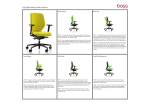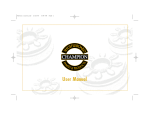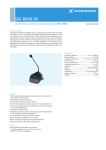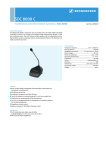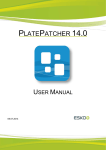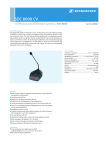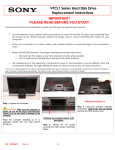Download Felix user guide.indd
Transcript
FELIX user guide 1) Back Height Why? It is important that the chair gives you support through the whole of your back. To do this the lumbar support on the chair must be aligned with your own lumbar region. How? Reach around and press the two buttons located on the inside of the dual Jbar. Raise the back until the pronounced lumbar support is aligned with your own lumbar region. Release the button when located in the correct position. The back will locate in one of eight positions. 2) Seat Height Why? To keep your thighs parallel to the floor and your elbows at a similar height to the keyboard. This helps to maintain a healthy posture with good circulation. How? Lift the paddle located under the right hand side of your seat, whilst lifting your weight out of the chair to allow the seat to rise to the desired position. To lower the height, lift the paddle again leaving your body weight on the seat. The seat will lock at the height at which the handle is released. The height adjustable arm will locate in one of eleven positions. 3) Arm Height Why? Forearms must be allowed to rest flat on the arm pads, allowing your shoulders to relax in order to eliminate some of the tension in your upper body. How? Press the buttons on the outside of the arm risers to raise and lower the arms. Ensure that both arm pads are the same height and release the button to lock into position. Set the arm height so that your forearms are set at 90º when your shoulders are relaxed. 4) Seat Depth Why? If your seat depth is too long you could compromise the circulation in your lower legs as well as being unable to make effective use of the back rest and will adopt a posture with a rounded spine. If it is too short, you will increase the pressure on your thighs. Ideally the front edge of the seat should be 5cm from the back of your calves. How? Whilst seated push the button on the right hand side of the seat and slide the seat into your desired position. Release the button to lock the seat. There is 70mm of movement in the seat slide which is a standard feature. 5) Back Recline Tension Why? It is important to allow your body to remain dynamic with the chair in its unlocked position, because a dynamic posture promotes good circulation and a healthy spine. The tension of the chair should be adjusted to suit your own weight so that your body moves freely and harmoniously with the chair rather than having to fight it. How? To unlock the back of the chair and allow it to move with your body, push down the paddle found under the left hand side of your seat. To adjust the tension to suit your own body weight, pull out the knob under the right-hand-side of the seat. Rotate it clockwise to increase the tension and anti-clockwise to decrease the tension. 6) Forward Seat Tilt Under the left-hand-side of your seat you will find a paddle, which can be set in any one of three positions. 1) When the paddle is in the raised position, the back angle will be locked in any one of three position 2) When the paddle is in the middle position the back is unlocked and remains in ‘free-float’ with the seat returning to a flat position (parallel to the floor) when the back is in the upright position. 3) When the paddle is in the lower position, the chair will remain in ‘free-float’. But the seat will return to a 3 degree forward tilt when the back is in the upright position.



